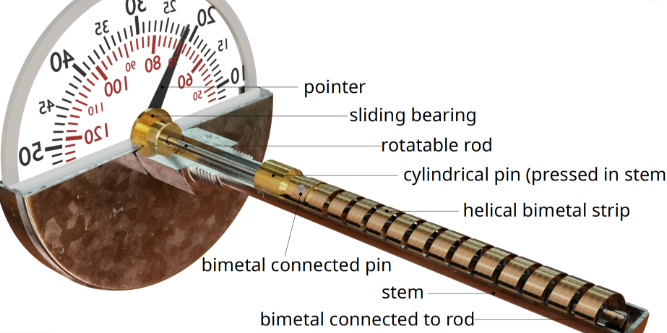This article establishes minimum requirements for the use of Bimetallic Thermometers in process plants.
Bimetallic Thermometers References
Reference is made in this standard to the following documents.
American Petroleum Institute (API)
RP 550 Manual on Installation of Refinery Instruments and Control Systems
RP 551 Process Measurement Instrumentation
American Society of Mechanical Engineers (ASME)
B40.3 Bimetallic Actuated Thermometers
Bimetallic Thermometers Definitions
For the purpose of understanding this standard, the following definitions apply:
Bimetallic Thermometers. The Bimetallic Thermometer consists of temperature sensitive element housed in a stainless steel sheath and connected to indicator enclosed in an integral case. Temperature
changes will cause the free end of the helix to rotate, actuating the indicator.
Bimetallic Thermometer Element. A temperature-sensitive strip of metal (or other configuration) made by bonding or mechanically joining two dissimilar strips of metal together so that small changes in
temperature will cause the composite assembly to distort elastically, and produce a predictable deflection; the element is designed to take advantage of the fact that different metals have different coefficients of thermal expansion.
Hermetically Sealed Element. A device which is sealed against the entrance of an external atmosphere and in which the seal is made by fusion, for example, soldering, brazing, welding, or the fusion of glass to
metal.
Intermittent Duty. An operating cycle that consists of alternating periods of use and idle time, for example, on and off, load and no-load, load and rest, or load, no-load and rest; in most instances,
successive periods of use or idle time vary widely in length, although some intermittent-duty cycles follow well-defined patterns.
Protecting Tube. A protecting tube is designed to enclose a temperature sensing device and protect it from the deleterious effects of the environment. It may provide for attachment to a connection head but is not primarily designed for pressure-tight attachment to a vessel.
Basic Bimetallic Thermometers Design Notes in Process Industry
- Thermometer accuracy shall be per ASME B40.3 standard Grade A (+/- 1% of span throughout)
- hermometer case diameter shall range from 1 to 6 inches with stem length from 2 1/2 to 24 inches.
- Thermometers shall be of industry standard lengths.
- Outside diameter of protecting tube shall be 1/4 inch.
- Thermometers case shall be made of stainless steel with water proof construction.
- Thermometers head shall be hexagonal or wrench flat.
- The installation of Bimetallic Thermometers shall conform to API RP 550/551.
- Thermowells shall be used with thermometers on any application involving high pressure, high velocity or corrosive fluids and both shall be purchased as an assembly. See R02-E06 for Thermowell details.
Bimetallic Thermometers Application
- Bimetallic Thermometer shall be used for local indications only.
- The use shall be restricted to temperature ranges of -70 °C (-100 °F) to 500 °C (1000 °F).
- Hermetically sealed elements shall be used for temperatures below -30 °C (-20 °F).
- The use of thermometers above 425 °C (800 °F) shall be limited to intermittent duty.
- Back connected or bottom connected models shall be specified depending on applications.
- When subjected to vibration, silicone oil filled thermometer shall be used
